How to Prevent Espresso Channeling & Achieve The Perfect Espresso Extraction
Have you ever wondered why your homemade espresso doesn’t quite taste up to the mark? Having made countless espresso shots, I know full well how espresso channeling is a common complaint among beginners and home baristas.
It may be a headscratcher, but my years making coffee have given me the knowledge to identify and fix espresso channeling.
So if you’re facing this dilemma, don’t fret, because I’ll be sharing with you everything you need to know about this channeling problem and make the perfectly extracted brew.
What is Espresso Channeling?
Espresso channeling occurs when water finds easier paths through the coffee puck during extraction, resulting in an imbalanced flow of water and an under-extracted or over-extracted shot.
Imagine your espresso puck packed snugly inside your portafilter. Instead of the water flowing equally in all of the tiniest spaces in between the grounds, it finds a path of least resistance, so more water gets through there while less water passes through the rest of the puck, resulting in fewer or too many coffee flavors joining your water.
The result? A disappointing cup of espresso.
What Causes Espresso Channeling?
There are several factors that can cause channeling, each playing its part in creating these unwanted pathways for your water. Let me shed some light on some of its main causes:
- Grind inconsistency: Inconsistent grind size can wreak havoc behind the scenes. Whether certain grinds are too coarse or fine compared to others, even subtle variances can impact the rate at which water flows through the coffee bed.
- Uneven distribution of coffee grounds: Imagine if you were pouring cake batter into a mold but only focused on filling just one side – unevenness becomes inevitable. Similarly, if your coffee grounds aren’t distributed evenly across the portafilter before tamping, they won’t allow an even flow during espresso brewing.
- Incorrect tamping pressure: Tamping serves as an equalizer; applying uniform compression allows for an even flow throughout the puck during extraction time. However, if you apply excessive or inadequate force in leveling your grounds, you can expect channeling to occur.
- Faulty or unclean equipment: Channeling is a problem that’s also common to faulty or unclean espresso coffee makers. Any clogs or mineral buildup that can interfere with your water flow affects the flavor and quality of the entire coffee.
How to Spot Channeling in Espresso
Your eyes and palate will be your trusty guide to know how to spot channeling in espresso. So pay close attention to these cues:
Visual cues indicating channeling
Keep an eye out for a few tell tale visual indicators during the extraction process. This is why I prefer bottomless portafilters over their spouted counterparts because I can clearly see the espresso flowing out of my machine.
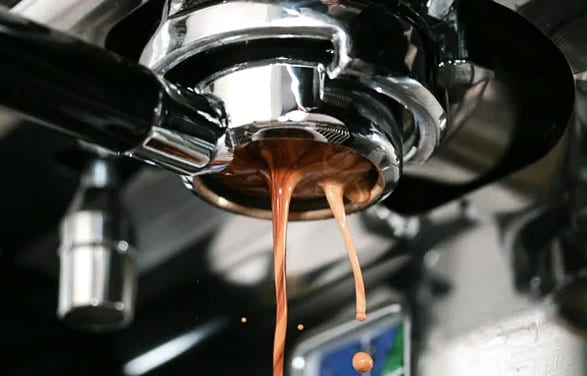
If you notice a rapid or uneven flow of espresso coming out too quickly or from certain spots only, chances are that channels have formed within the coffee puck.
Additionally, a wet and sloppy-looking coffee puck after extraction suggests poor coffee distribution and potential channel development. Remember, we want a well-structured bed with consistent saturation throughout.
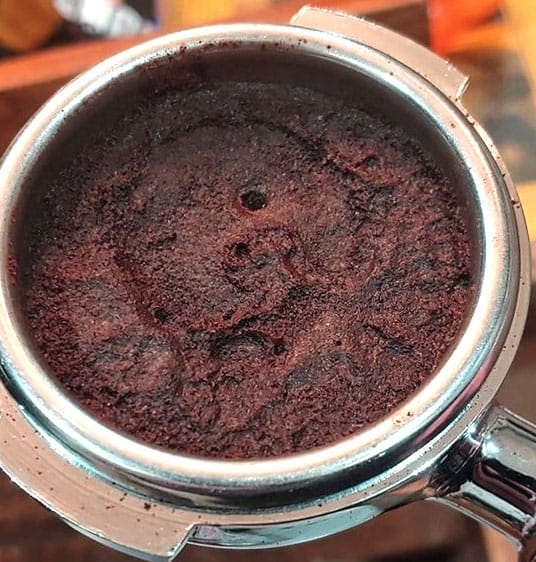
Basing on taste
Your taste buds are also helpful tools in identifying if your espresso shot is channeled. For one, the resulting flavor profile may be underwhelming due to insufficient extraction from areas bypassed by water flowing through other channels more rapidly.
This often results in weak flavors combined with bitter or sour notes instead of balanced richness – not exactly what I’d call delightful.
So keep these observations handy whenever you pull shots and strive for balance in both visuals and taste. You can read my article on how to recognize a great espresso for more ways to know a delicious cup.
7 Ways To Fix Espresso Channeling
As a barista, I have encountered my fair share of espresso channeling issues. It can be frustrating to see the uneven flow and inconsistent extraction of espresso shots.
Here are my tried and tested tricks to fix this problem:
1. Utilize techniques to distribute the coffee properly
One common cause of channeling is an uneven distribution of coffee grounds in the portafilter. To solve this issue, make sure to distribute the grounds evenly by gently tapping the side of the portafilter or using a distribution tool. This will ensure that the water will flow through all parts of the puck equally.
After trying a bunch of puck prep tools, I can confidently say that a WDT tool is the single most useful thing you can get for consistently even pucks.
If you’re still struggling with proper distribution though, you can also try using an espresso puck screen that prevents grounds from getting stuck in the shower screen promoting proper distribution of the ground coffee.
Click here to read more on espresso puck screens.
2. Check your grinds
Another factor that contributes to channeling is grind inconsistency. If your espresso shot is flowing too fast or slow during extraction, it may be necessary to adjust your grind size accordingly:
- Finer grinds will slow down the flow
- Coarser grinds will speed it up.
Experimentation plays a crucial role here since different beans and roast levels require varying grind sizes for optimal flow rates without channeling issues. I recommend grabbing a notebook and pen to write down the different results as you brew, and you’ll soon get a good grasp on how each variable affects your cup.
Consistency is key when it comes to the grams of coffee you use for each shot. Properly weighing and distributing an equal amount of coffee in the portafilter helps with even extraction, minimizing the chance of channeling. Read my guide on dosing espresso to know how much ground coffee you really need.
3. Ginder troubles?
Inconsistent grinds can also lead to channeling.
It’s best to invest in a quality burr grinder if you don’t have one yet. It is essential for consistent coffee grinding.
1Zpresso makes some great manual burr grinders, but if you make a lot of espresso, I would go with an electric grinder like these instead.
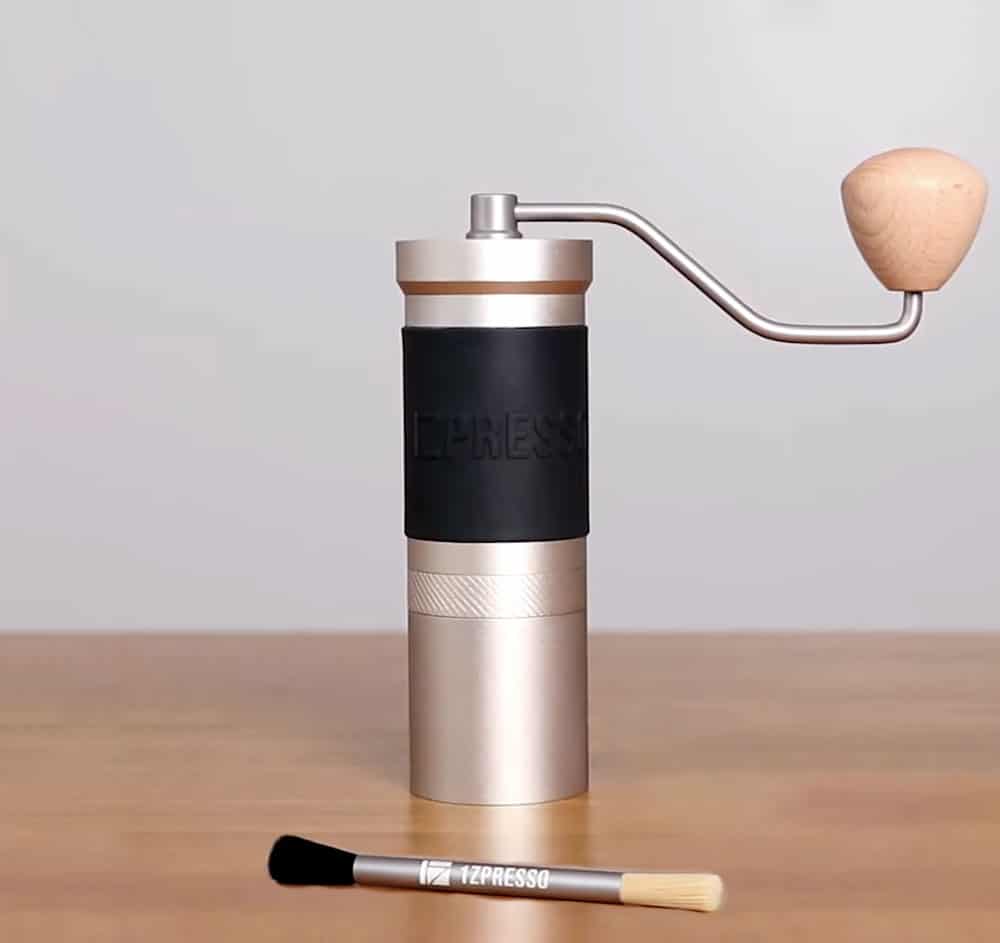
4. Check your tamping pressure
Tamping with uniform pressure helps create a level surface and prevents water from finding paths around channels in the coffee puck.
Make sure your tamper provides an even distribution of force and practice consistency when applying pressure while tamping. Check out my detailed guide on mastering espresso tamping to get the best results in your cup.
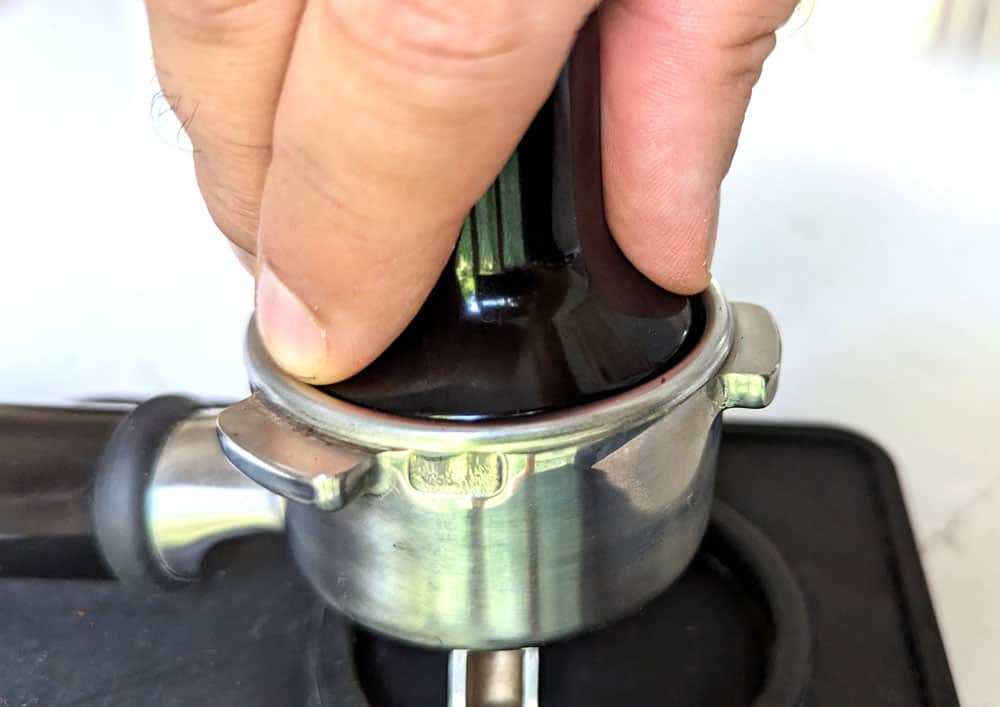
Investing in a good-quality tamper can make all the difference. When I was starting out as a barista, I used to think that I was struggling with my tamping technique only to realize that it was actually my tamper that was the problem.
Make sure to choose one that fits your hand comfortably and allows you to apply consistent pressure throughout the entire tamping process.
Also, the stock tamper that comes with your coffee machine might not be a perfect fit. If it wiggles around in your portafilter basket, you should get a tamper that fits without moving around.
Barista Tip: After tamping, don’t hit your portafilter against anything or touch your puck, as it can create cracks in the puck, which lead to channeling.
5. Keep your espresso machine clean and maintained
A clean machine ensures proper extraction and reduces the chances of channeling caused by buildup or clogs within components such as group heads or dispersion screens.
Regular cleaning maintenance should include backflushing, replacing seals, descaling as needed, and removing any residual oils from portafilter baskets. A mixture of equal parts water and white vinegar is an effective cleaning solution, but there are also alternatives you can use instead.
6. Choose a bottomless portafilter
A bottomless or “naked” portafilter provides immediate visual feedback during extraction, allowing you to see any signs of channeling instantly. This tool gives valuable insight into how evenly your espresso is flowing through the puck.
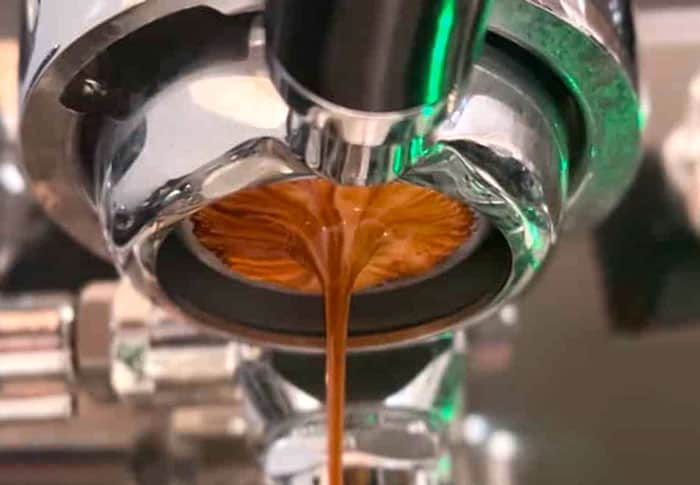
7. Use preinfusion before applying full pressure
Preinfusion wets the entire coffee puck at around 1-2 bars of pressure, before ramping up to full extraction pressure (9 bars).
This technique basically wets the coffee bed and can help with channeling, but it’s not a cure in itself.
Frequently Asked Questions (FAQs)
Here are some answers to the common questions about espresso channeling:
Not necessarily. Espresso channeling is more related to the preparation process like incorrect tamping pressure, uneven distribution of grounds or grind inconsistency, rather than the type of beans. However, freshly roasted beans can provide a better taste profile resulting in good espresso.
Not necessarily. Espresso channeling is more related to the preparation process like incorrect tamping pressure, uneven distribution of grounds or grind inconsistency, rather than the type of beans. However, freshly roasted beans can provide a better taste profile resulting in good espresso.
Other than visual cues from your bottomless portafilter during extraction and the taste, you can also inspect your used coffee puck after extraction. A soggy or sloppy-looking puck of coffee in the portafilter basket suggests uneven water distribution in your espresso shot which could have been caused by channeling.
Absolutely. A clean machine is essential for consistent flavor and prevents build-up that could impact water distribution through the coffee puck resulting in channeling. Regularly clean your equipment following the manufacturer’s guidelines to ensure optimum performance.
Pre-infusion means soaking the coffee grounds with water before the full-pressure extraction. This method clears any air pockets in your puck to help ward off channeling. If each little piece of coffee is soaked evenly, it lessens the chance for water to seek out easy travel routes, hence stopping channeling from happening as we draw out its flavor.
The culprit of channeling in your espresso can also be the pressure of your machine. Adjusting your puck for a high pressure of 10-11 bars is trickier than the usual 9 bars of pressure. Dial it back to 9 bars if you can control it on your machine.
Final thoughts on preventing channeling
If your espresso shots just don’t taste right, you might have an espresso channeling problem. Don’t sweat it though, channeling is a common hiccup experienced by many, and rest assured, there’s a solution waiting.
Here’s my advice: distribute the coffee grounds evenly, tweak your grind size until it feels right, exert consistent pressure every time you tamp, and consistently keep all of your gears sparkling clean. Always remember that the quality of your cup relies significantly on the beans themselves – freshness is key.
So do yourself a favor and stick to these pointers for properly distributed coffee and delicious espresso. It’d be such a shame to invest in premium roasted coffee beans (especially specialty coffee) only to lose its exquisite potential to channeling.

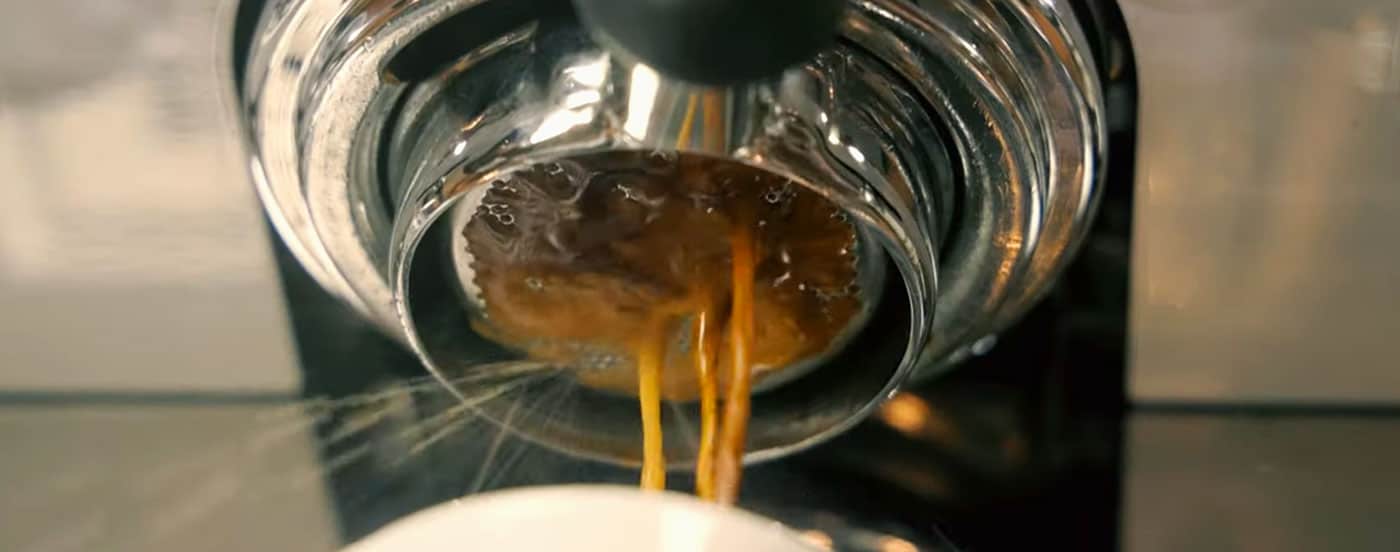
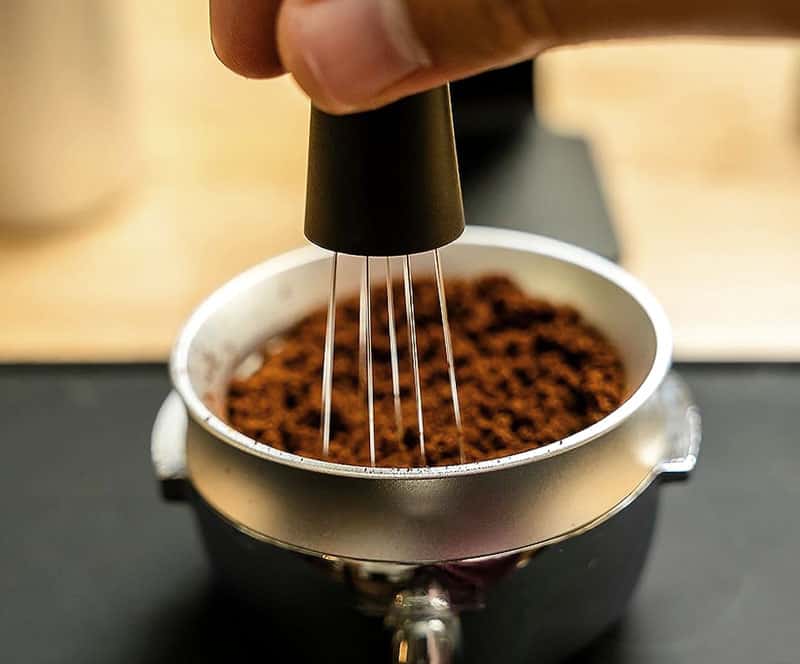





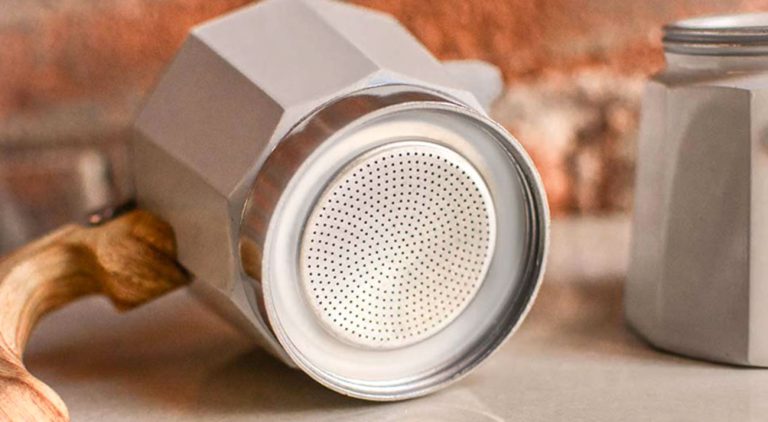
Wow, never realized how my cleaning routine could be affecting channeling. Quick question for Tom or anyone else who might know: How often should I be descaling my machine to keep it in top-notch condition and prevent any unwanted channeling?
My problem seems to stubbornly persist. I’ve done everything by the book – consistent tamping pressure, checked my grinder, and I clean regularly. Could there be another subtle reason for channeling that’s commonly overlooked? Seeking advice.
Are you using a WDT tool? You didn’t mention that. In my experience, this is the main culprit behind channeling.
Excellent overview on Channeling, Tom. As someone who trains baristas, I feel it’s important to emphasize the role of proper bean storage and its impact on grind consistency. If the beans have overly fluctuated in terms of humidity or are stale, it can lead to uneven extraction regardless of how precisely you follow the steps listed. It’s all part of the meticulous art of espresso-making.
What a timely article, your tips on fixing espresso channeling practically saved my morning ritual, I was on the verge of giving up. After reading, I immediately checked my grinder settings and realized my grind size was the culprit. A quick adjustment and my espresso has never tasted better—no more sour, uneven shots. Thank you for sharing your knowledge Tom.
I’ve been pulling shots for years, and the suggestion to use a bottomless portafilter is spot-on. It really helps you see the channeling as it happens. Ever since I made the switch and realized that my shot was spraying all of the place, and fixing it, the quality of my espresso has improved dramatically. It’s a game-changer for any espresso aficionado.